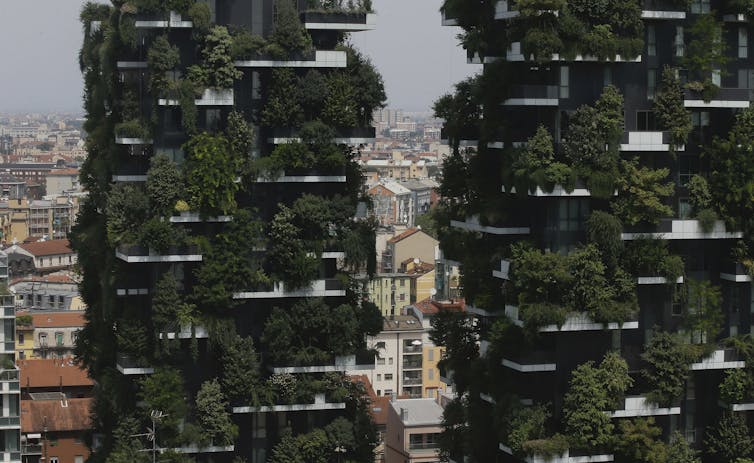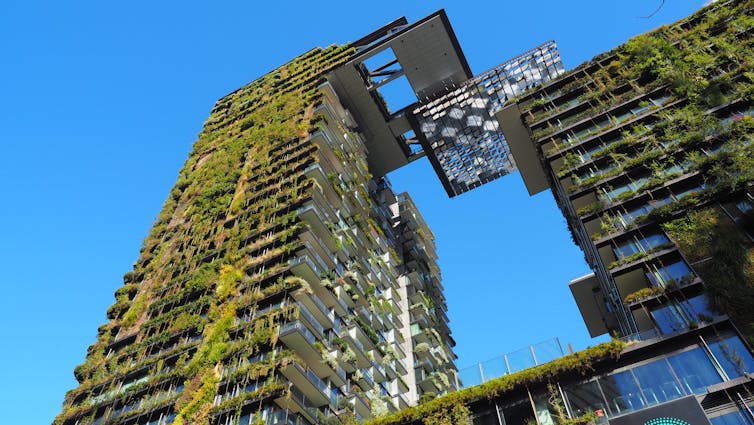Green buildings can bring fresh air to design, but they can also bring pests
- Written by Norman Day, Lecturer in Architecture, Practice and Design, Swinburne University of Technology
Throughout the world architects are designing green buildings, whether it’s in their sustainable construction, environmentally friendly operation or actually green by style.
It’s broadly titled biophilia, connecting people with nature, and it can lead to some creative and innovative designs.
But now we are finding that literally greening the world — by covering building walls and roofs with vegetation — can also come with some unexpected problems.
Read more: Greening our grey cities: here's how green roofs and walls can flourish in Australia
A bug’s high life
In the Chinese city of Chengdu, a vast green experimental housing estate of 826 apartments was constructed where people can live in a vertical forest with every open space and balcony containing live vegetation.
Trouble is they must share the plants with a scourge of mosquitoes and other bugs. Most apartments in the Qiyi City Forest Gardens development were sold by April 2020, but six months later only a handful of families had reportedly moved in.
The towers were built in 2018 and plants were provided to reduce noise and clean up pollution. But the plants thrived, while sales moved slowly, and no one was clipping the greenery to keep it in control.
Read more: Unbuilding cities as high-rises reach their use-by date
Now mostly empty balconies have cascading branches of plants overtaking space, blocking windows.
It might not help that Chengdu and its population of 16.3 million people are located in Sichuan, central China, which is humid and semi-tropical, a perfect environment for fast-breeding mossies.
But a slow uptake, with tenants slow to move in, made the problem worse as the plants subsumed their buildings.
Some vertical vegetation living success
Other green projects across the globe have avoided this particular problem, so far.
Milan’s Bosco Verticale (Vertical Forest) was designed by Stefano Boeri and botanist Laura Gatti.
They reportedly spent long hours selecting suitable vegetation, a variety of 800 trees, 5,000 shrubs and 15,000 plants, which would suit their location and the Milanese climate.
Read more: Australian cities are lagging behind in greening up their buildings
 The twin towers of the Bosco Verticale residential buildings in Milan, Italy.
AP Photo/Luca Bruno
The twin towers of the Bosco Verticale residential buildings in Milan, Italy.
AP Photo/Luca Bruno
Their plan was to improve air quality in the city via the green facades, and residents have embraced the concept, which appears to be where Qiyi City Forest has gone wrong.
In Chengdu, maintenance and care of the plantings is almost non-existent, so no truly symbiotic relationship between accommodation and human occupier has formed as part of biophilic living. As is nature’s way, the non-human occupiers (the bugs) are winning.
Gardens need a gardener
US landscape architect Daryl Beyers, from the New York Botanical Garden, says the Chengdu setup didn’t work partly as a result of bad design.
In Chengdu’s humid climate and clammy monsoons, stagnant water collects in planters which are not properly drained, and mosquitoes breed in these.
Beyers adds:
They [the developers] didn’t think about the maintenance […] You can’t have a garden without a gardener.
They were touting it as a manicured garden outside on your deck. If it’s manicured, someone has to do the manicuring.
The idea of fully manicured vegetation on balconies only works if the plants are cared for regularly. Apparently, gardeners attend Qiyi City just four times a year to maintain the plants, but they require weekly care.
Sydney’s green space on the up
One Central Park apartments in Sydney, by French architect Jean Nouvel, takes on a green mantle with plants covering most of its walls and balconies.
 One Central Park is the world’s largest vertical gardens.
Shutterstock/SAKARET
One Central Park is the world’s largest vertical gardens.
Shutterstock/SAKARET
French botanist Patrick Blanc selected the plants on the building for their capacity for healthy growth and suitability to the Sydney habitat.
By using acacias (wattles) and poa (grasses) on upper levels and goodenia (hop bush) and viola (native violet) lower down, the vegetation is attuned to its place and growing successfully.
More than 1,100 square metres of walls support many species of plants, most of them native to Sydney. They are at home with the local climate and seasons. The plants can withstand hot, dry and windy Australian summers and have survived since 2014.
How to green your buildings
Green buildings are necessary for the environment. We need to redress the loss of our natural resources and their benefits, and green buildings can do that by adopting appropriate design, energy efficiencies, renewable materials and green technologies.
Read more: A third of our waste comes from buildings. This one's designed for reuse and cuts emissions by 88%
Central Park’s success could be emulated at Chengdu, by tracing back the original design intent and adopting a workable maintenance and management plan.
The lessons from both projects indicate that proper planning and appropriate selection of vegetation, which is then fed and watered by applicable technology, will yield a proficient green building.
People feel comfort living with nature, and a vertical garden gives those in high-rise towers a chance to share that comfort. But with the benefits come responsibilities.
The clue here is that a faithfully biophilic building must be appropriate for use. That means appropriate in terms of the place, natural resources, local climate and the people who must manage and occupy the natural surroundings.
Authors: Norman Day, Lecturer in Architecture, Practice and Design, Swinburne University of Technology





